Ru Single Atoms on One-Dimensional CF@g-C3N4 Hierarchy as Highly Stable Catalysts for Aqueous Levulinic Acid Hydrogenation
Abstract
:1. Introduction
2. Experimental
2.1. Chemicals
2.2. Sample Preparation
2.3. Characterization
2.4. Catalytic Test
3. Results and Discussion
4. Conclusions
Supplementary Materials
Author Contributions
Funding
Institutional Review Board Statement
Informed Consent Statement
Data Availability Statement
Acknowledgments
Conflicts of Interest
References
- Zhou, C.H.; Xia, X.; Lin, C.X.; Tong, D.S.; Beltramini, J. Catalytic conversion of lignocellulosic biomass to fine chemicals and fuels. Chem. Soc. Rev. 2011, 40, 5588–5617. [Google Scholar] [CrossRef] [PubMed]
- Wright, W.R.H.; Palkovits, R. Development of heterogeneous catalysts for the conversion of levulinic acid to γ-valerolactone. ChemSusChem 2012, 5, 1657–1667. [Google Scholar] [CrossRef] [PubMed]
- Alonso, D.M.; Wettstein, S.G.; Dumesic, A.J. Dumesic, Gamma-valerolactone, a sustainable platform molecule derived from lignocellulosic biomass. Green Chem. 2013, 15, 584–595. [Google Scholar] [CrossRef]
- Feng, H.J.; Li, X.C.; Qian, H.; Zhang, Y.F.; Zhang, D.H.; Zhao, D.; Hong, S.G.; Zhang, N. Efficient and sustainable hydrogenation of levulinic-acid to gamma-valerolactone in aqueous solution over acid-resistant CePO4/Co2P catalysts. Green Chem. 2019, 21, 1743–1756. [Google Scholar] [CrossRef]
- Liu, F.; Ftouni, J.; Bruijnincx, P.C.A.; Weckhuysen, B.M. Phase-dependent stability and substrate-induced deactivation by strong metal-support interaction of Ru/TiO2 catalysts for the hydrogenation of levulinic acid. ChemCatChem 2019, 11, 2079–2088. [Google Scholar] [CrossRef]
- Abdelrahman, O.A.; Heyden, A.; Bond, J.Q. Analysis of kinetics and reaction pathways in the aqueous-phase hydrogenation of levulinic acid to form γ-valerolactone over Ru/C. ACS Catal. 2014, 4, 1171–1181. [Google Scholar] [CrossRef]
- Barbaro, P.; Liguori, F.; Linares, N.; Marrodan, C.M. Heterogeneous bifunctional metal/acid catalysts for selective chemical processes. Eur. J. Inorg. Chem. 2012, 24, 3807–3823. [Google Scholar] [CrossRef]
- Yang, Y.; Sun, C.J.; Ren, Y.; Hao, S.J.; Jiang, D.Q. New route toward building active ruthenium nanoparticles on ordered mesoporous carbons with extremely high stability. Sci. Rep. 2014, 4, 4540. [Google Scholar] [CrossRef] [Green Version]
- Liu, L.C.; Corma, A. Metal catalysts for heterogeneous catalysis: From single atoms to nanoclusters and nanoparticles. Chem. Rev. 2018, 118, 4981–5079. [Google Scholar] [CrossRef] [Green Version]
- Tian, S.B.; Wang, Z.Y.; Gong, W.B.; Chen, W.X.; Feng, Q.C.; Xu, Q.; Chen, C.; Chen, C.; Peng, Q.; Gu, L.; et al. Temperature-controlled selectivity of hydrogenation and hydrodeoxygenation in the conversion of biomass molecule by the Ru1/mpg-C3N4 catalyst. J. Am. Chem. Soc. 2018, 140, 11161–11164. [Google Scholar] [CrossRef]
- Peng, Y.; Pan, W.Z.; Wang, N.; Lu, J.E.; Chen, S.W. Ruthenium ion-complexed graphitic carbon nitride nanosheets supported on reduced graphene oxide as high-performance catalysts for electrochemical hydrogen evolution. ChemSusChem 2018, 11, 130–136. [Google Scholar] [CrossRef]
- Zhang, C.H.; Sha, J.W.; Fei, H.L.; Liu, M.J.; Yazdi, S.; Zhang, J.B.; Zhong, Q.F.; Zou, X.L.; Zhao, N.Q.; Yu, H.S.; et al. Single-atomic ruthenium catalytic sites on nitrogen-doped graphene for oxygen reduction reaction in acidic medium. ACS Nano 2017, 11, 6930–6941. [Google Scholar] [CrossRef] [Green Version]
- Wang, X.; Chen, W.X.; Zhang, L.; Yao, T.; Liu, W.; Lin, Y.; Ju, H.X.; Dong, J.C.; Zheng, L.R.; Yan, W.S.; et al. Uncoordinated amine groups of metal-organic frameworks to anchor single Ru sites as chemoselective catalysts toward the hydrogenation of quinoline. J. Am. Chem. Soc. 2017, 139, 9419–9422. [Google Scholar] [CrossRef]
- Cao, W.X.; Luo, W.H.; Ge, H.G.; Su, Y.; Wang, A.Q.; Zhang, T. UiO-66 derived Ru/ZrO2@C as a highly stablecatalyst for hydrogenation of levulinic acid to γ-valerolactone. Green Chem. 2017, 19, 2201–2211. [Google Scholar] [CrossRef]
- Geng, Z.G.; Liu, Y.; Kong, X.D.; Li, P.; Li, K.; Liu, Z.Y.; Du, J.J.; Shu, M.; Si, R.; Zeng, J. Achieving a record-high yield rate of 120.9 μgNH3 mgcat.−1 h−1 for N2 electrochemical reduction over Ru single-atom catalysts. Adv. Mater. 2018, 30, 1803498. [Google Scholar] [CrossRef]
- Liu, W.G.; Chen, Y.J.; Qi, H.F.; Zhang, L.L.; Yan, W.S.; Liu, X.Y.; Yang, X.F.; Miao, S.; Wang, W.Y.; Liu, C.G.; et al. A durable nickel single-atom catalyst for hydrogenation reactions and cellulose valorization under harsh conditions. Angew. Chem. Int. Ed. 2018, 57, 7071–7075. [Google Scholar] [CrossRef]
- Shi, J.L. Single-atom Co-doped MoS2 monolayers for highly active biomass hydrodeoxygenation. Chem 2017, 2, 459–469. [Google Scholar] [CrossRef] [Green Version]
- Ding, X.H.; Li, Y.C.; Li, C.H.; Wang, W.T.; Wang, L.; Feng, L.J.; Han, D.Z. 2D visible-light-driven TiO2@Ti3C2/g-C3N4 ternary heterostructure for high photocatalytic activity. J. Mater. Sci. 2019, 54, 9385–9396. [Google Scholar] [CrossRef]
- Jiang, J.; Zhu, J.H.; Ai, W.; Fan, Z.X.; Shen, X.N.; Zou, C.J.; Liu, J.P.; Zhang, H.; Yu, T. Evolution of disposable bamboo chopsticks into uniform carbon fibers: A smart strategy to fabricate sustainable anodes for Li-ion batteries. Energy Environ. Energy Environ. Sci. 2014, 7, 2670–2679. [Google Scholar] [CrossRef] [Green Version]
- Yuan, T.; Wang, A.J.; Fang, K.M.; Wang, Z.G.; Feng, J.J. Hydrogen evolution-assisted one-pot aqueous synthesis of hierarchical trimetallic PdNiRu nanochains for hydrazine oxidation reaction. J. Energy Chem. 2017, 26, 1231–1237. [Google Scholar] [CrossRef]
- Wang, H.; Yang, H.X.; Lu, L. Topotactically synthesized TiO2 nanowires as promising anode materials for high-performance lithium-ion batteries. Energy Procedia 2014, 61, 2562–2566. [Google Scholar] [CrossRef] [Green Version]
- Kruk, M.; Jaroniec, M. Gas adsorption characterization of ordered organic-inorganic nanocomposite materials. Chem. Mater. 2001, 13, 3169–3183. [Google Scholar] [CrossRef]
- Yang, J.; Chen, B.X.; Liu, X.K.; Liu, W.; Li, Z.J.; Dong, J.C.; Chen, W.X.; Yan, W.S.; Yao, T.; Duan, X.Z.; et al. Efficient and robust hydrogen evolution: Phosphorus nitride imide nanotubes as supports for anchoring single ruthenium sites. Angew. Chem. Int. Ed. 2018, 57, 9495–9500. [Google Scholar] [CrossRef]
- Yang, Y.; Gao, G.; Zhang, X.; Li, F.W. Facile fabrication of composition-tuned Ru–Ni bimetallics in ordered mesoporous carbon for levulinic acid hydrogenation. ACS Catal. 2014, 4, 1419–1425. [Google Scholar] [CrossRef]
- Yang, Y.; Zhang, S.Y.; Gu, L.; Shao, S.; Li, W.; Zeng, D.H.; Yang, F.; Hao, S.J. Stable yolk-structured catalysts towards aqueous levulinic acid hydrogenation within a single Ru nanoparticle anchored inside the mesoporous shell of hollow carbon spheres. J. Colloid Interface Sci. 2020, 576, 394–403. [Google Scholar] [CrossRef]
- Zitolo, A.; Goellner, V.; Armel, V.; Sougrati, M.T.; Mineva, T.; Stievano, L.; Fonda, E.; Jaouen, F. Identification of catalytic sites for oxygen reduction in iron- and nitrogen-doped graphene materials. Nat. Mater. 2015, 14, 937–942. [Google Scholar] [CrossRef]
- Cheng, Q.Q.; Han, S.B.; Mao, K.; Chen, C.; Yang, L.J.; Zou, Z.Q.; Gu, M.; Hu, Z.; Yang, H. Co nanoparticle embedded in atomically-dispersed Co-N-C nanofibers for oxygen reduction with high activity and remarkable durability. Nano Energy 2018, 52, 485–493. [Google Scholar] [CrossRef]
- Peng, Y.; Lu, B.Z.; Chen, L.M.; Wang, N.; Lu, J.E.; Ping, Y.; Chen, S.W. Hydrogen evolution reaction catalyzed by ruthenium ion-complexed graphitic carbon nitride nanosheets. J. Mater. Chem. A 2017, 5, 18261–18269. [Google Scholar] [CrossRef]
- Abouali, S.; Garakani, M.A.; Xu, Z.L.; Kim, J.K. NiCo2O4/CNT nanocomposites as bi-functional electrodes for Li ion batteries and supercapacitors. Carbon 2016, 102, 262–272. [Google Scholar] [CrossRef]
- Matsumoto, K.; Matsumoto, T.; Kawano, M.i.; Ohnuki, H.; Shichi, Y.; Nishide, T.; Sato, T.J. Syntheses and Crystal Structures of Disulfide-Bridged Binuclear Ruthenium Compounds: The First UV–Vis, Raman, ESR, and XPS Spectroscopic Characterization of a Valence-Averaged Mixed-Valent RuIIISSRuII Core. Am. Chem. Soc. 1996, 118, 3597–3609. [Google Scholar] [CrossRef]
- Liu, S.L.; Wang, Z.G.; Xu, X.B.; Ding, Y.T.; Guo, Z. Production of conjugated linoleic acid-rich cottonseed oil by supported Ru catalyzed isomerisation. Ind. Crops Prod. 2017, 97, 10–20. [Google Scholar] [CrossRef]
- Zhang, X.; Luo, L.; Yun, R.P.; Pu, M.; Zhang, B.; Xiang, X. Increasing the Activity and Selectivity of TiO2-Supported Au Catalysts for Renewable Hydrogen Generation from Ethanol Photoreforming by Engineering Ti3+ Defects. ACS Sustain. Chem. Eng. 2019, 7, 13856–13864. [Google Scholar] [CrossRef]
- Kuai, L.; Chen, Z.; Liu, S.J.; Kan, E.J.; Yu, N.; Ren, Y.M.; Fang, C.H.; Li, X.Y.; Li, Y.D.; Geng, B.Y. Titania supported synergistic palladium single atoms and nanoparticles for room temperature ketone and aldehydes hydrogenation. Nat. Commun. 2020, 11, 48–56. [Google Scholar] [CrossRef] [Green Version]
- Zhang, L.K.; Shang, N.Z.; Gao, S.T.; Wang, J.M.; Meng, T.; Du, C.C.; Shen, T.D.; Huang, J.Y.; Wu, Q.H.; Wang, H.J.; et al. Atomically dispersed Co catalyst for efficient hydrodeoxygenation of lignin-derived species and hydrogenation of nitroaromatics. ACS Catal. 2020, 10, 8672–8682. [Google Scholar] [CrossRef]
- Li, X.N.; Huang, X.; Xi, S.B.; Miao, S.; Ding, J.; Cai, W.Z.; Liu, S.; Yang, X.L.; Yang, H.B.; Gao, J.J.; et al. Single cobalt atoms anchored on porous N-doped graphene with dual reaction sites for efficient fenton-like catalysis. J. Am. Chem. Soc. 2018, 140, 12469–12475. [Google Scholar] [CrossRef]
- Verma, S.; Baig, R.B.N.; Nadagouda, M.N.; Varma, R.S. Sustainable strategy utilizing biomass: Visible-light-mediated synthesis of γ-valerolactone. ChemCatChem 2016, 8, 690–693. [Google Scholar] [CrossRef]
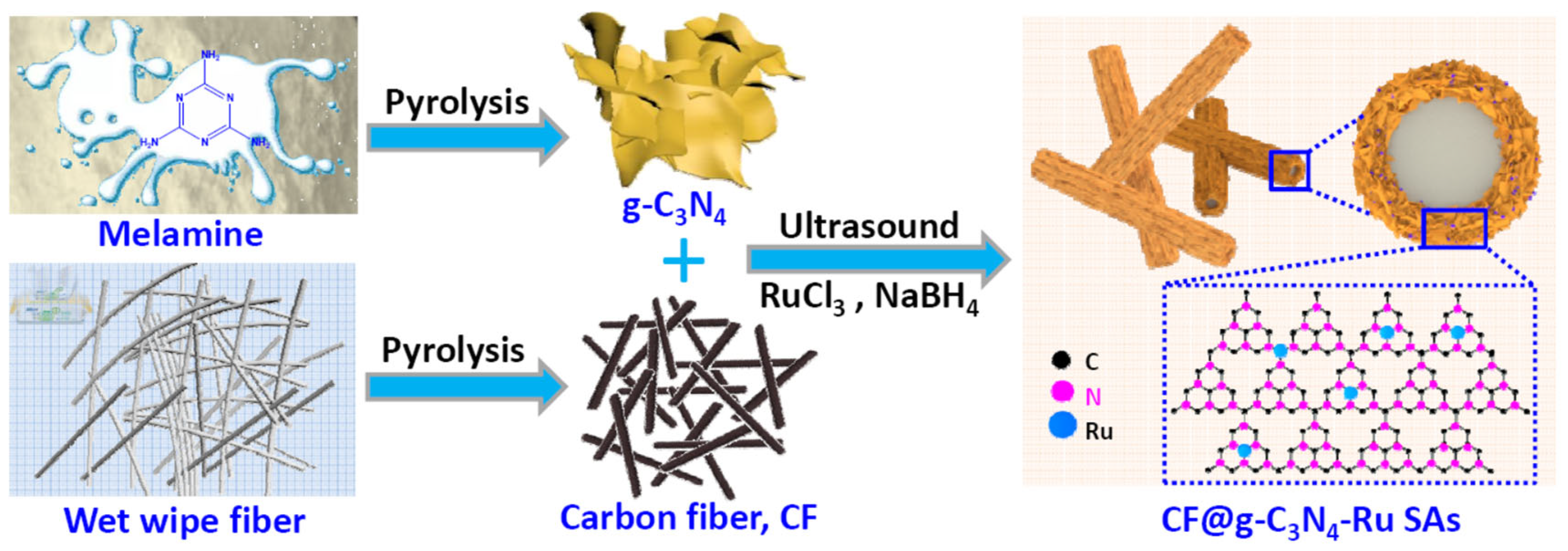
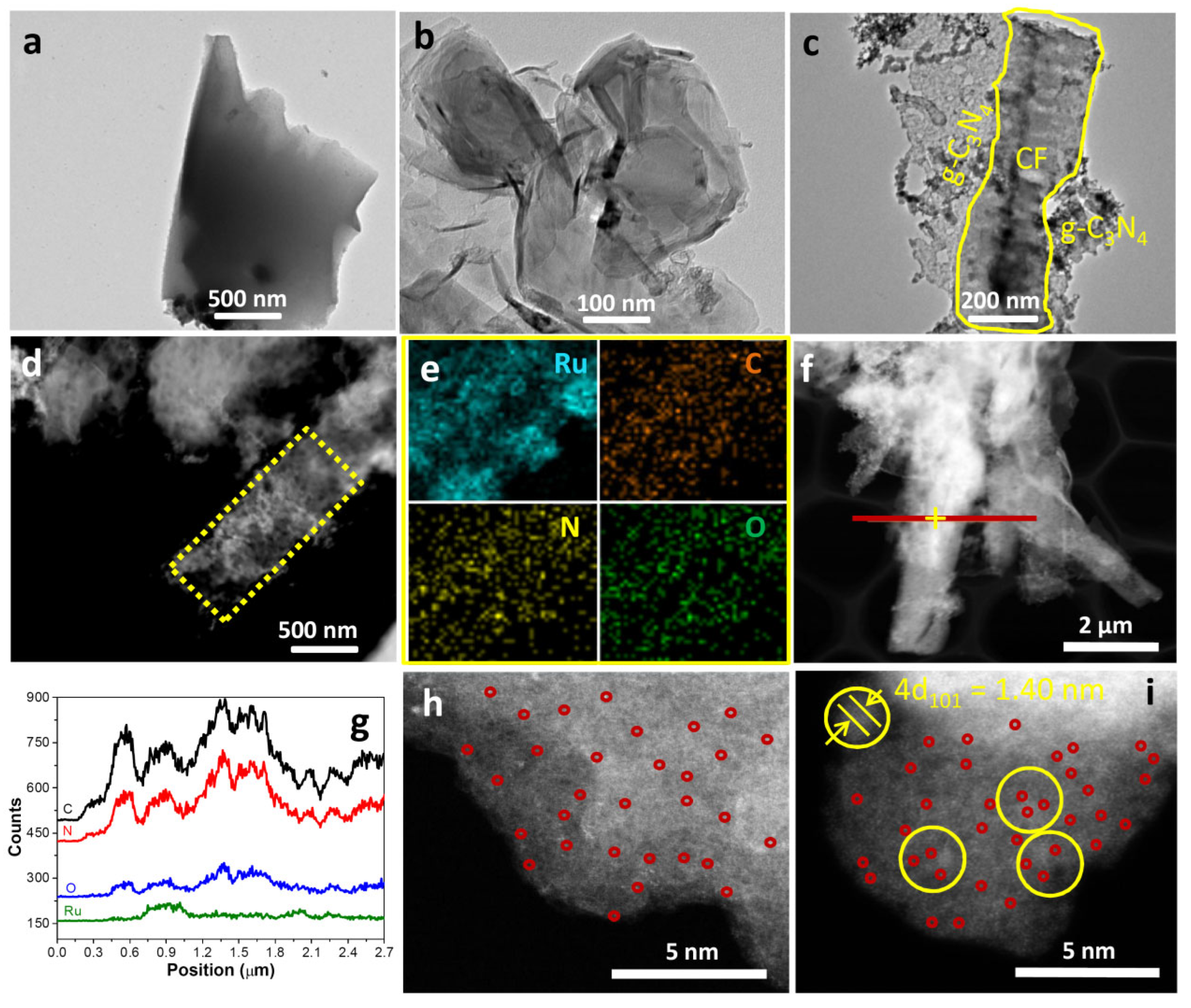

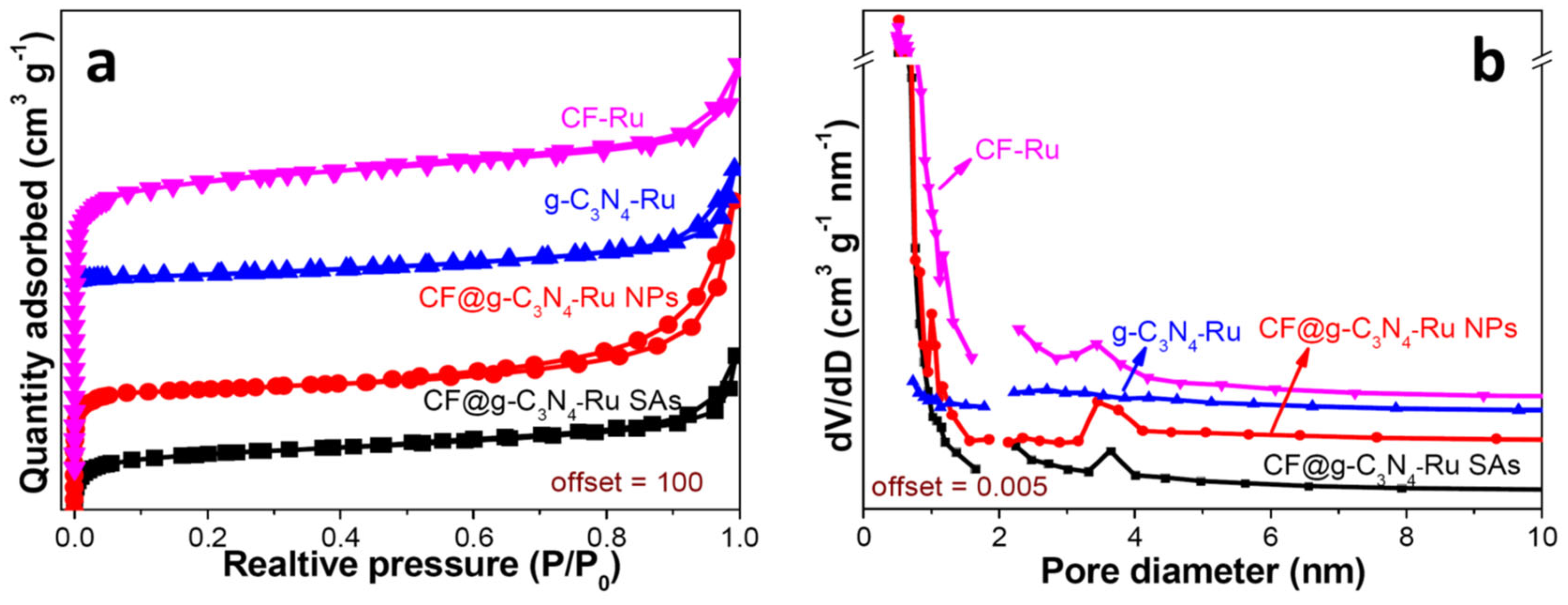
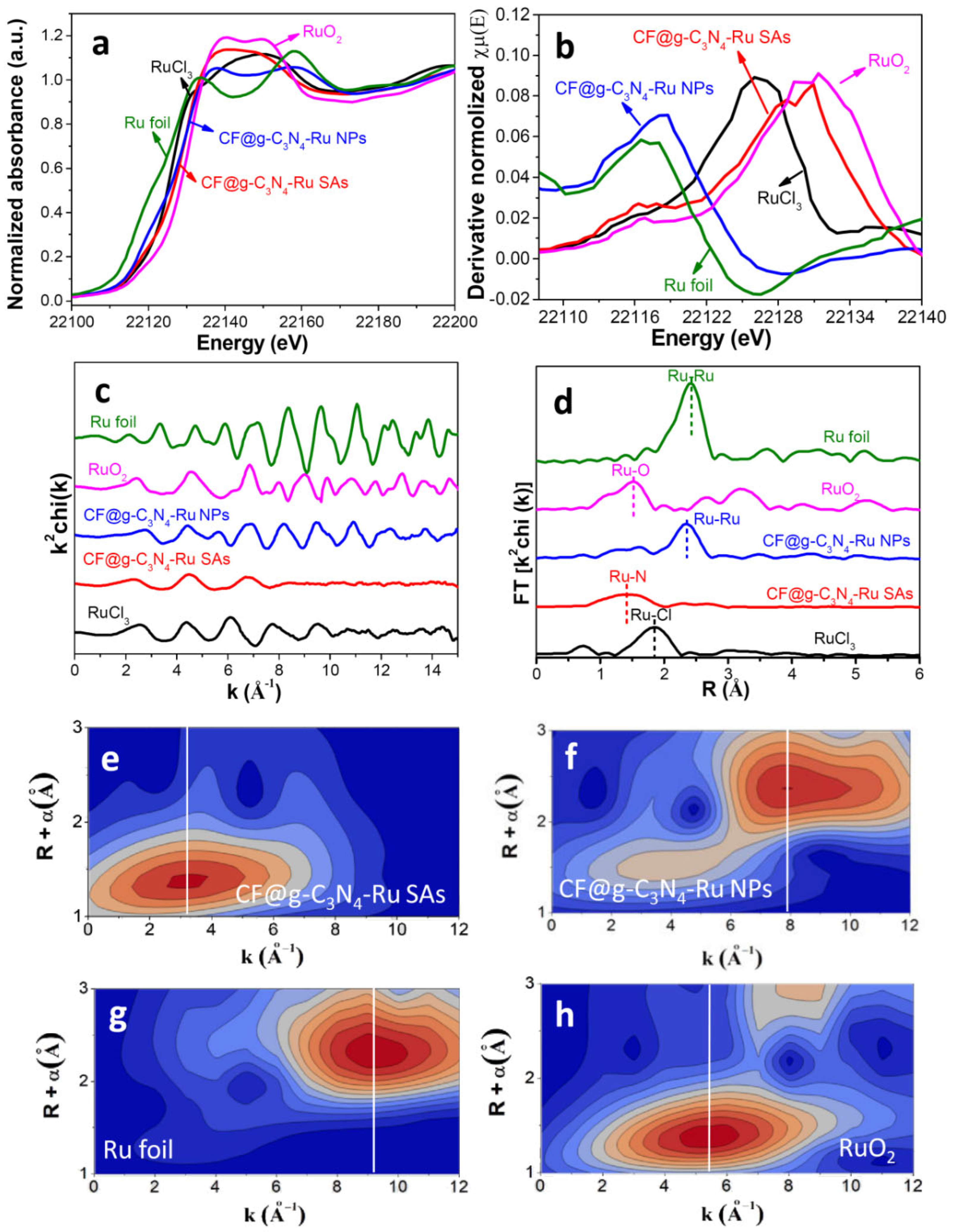
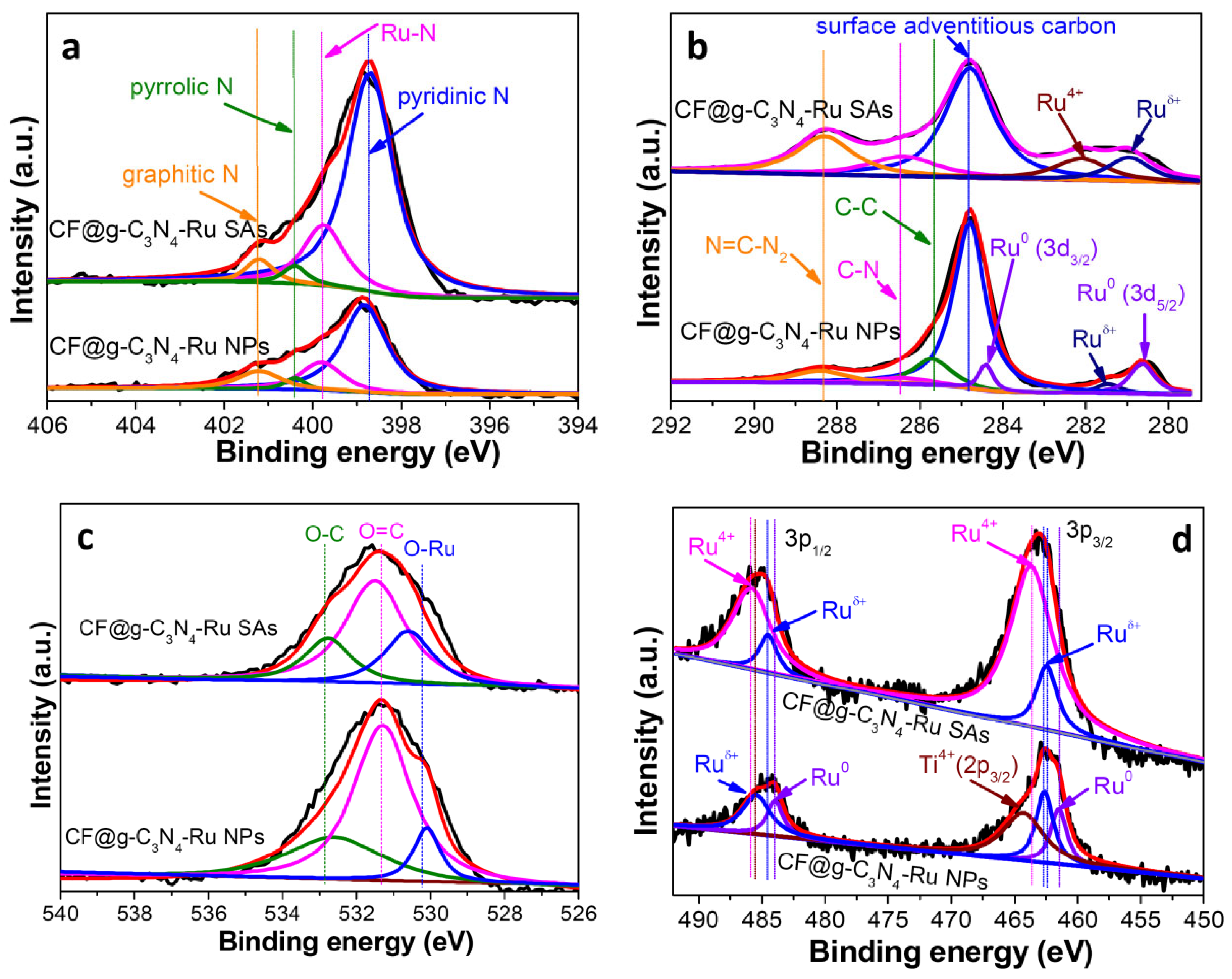

| Sample | Absorber- Scatter Pair | Coordination Number | Bond Distance (Å) | [σ2] a | ΔE0 a (eV) | R Factor |
|---|---|---|---|---|---|---|
| CF@g-C3N4–Ru SAs | Ru-N | 5.3 | 2.03 | 0.0081 | 0.600 | 0.023 |
| CF@g-C3N4–Ru NPs | Ru-N | 1.4 | 1.95 | 0.0007 | −8.50 | 0.019 |
| Ru-Ru | 8.8 | 2.68 | 0.0055 | −3.70 | ||
| RuO2 | Ru-O | 4.0 | 1.98 | 0.0014 | 0.279 | 0.029 |
| Ru-Ru | 2.0 | 3.10 | 0.0030 | −8.075 | ||
| RuCl3 | Ru-Cl | 6.0 | 2.36 | 0.0075 | −0.873 | 0.099 |
| Ru-Ru | 2.0 | 2.98 | 0.0130 | −9.249 | ||
| Ru foil | Ru-Ru | 12.0 | 2.68 | 0.0048 | 3.663 | 0.007 |
| Entry | Catalyst | LA Conversion a (%) | Selectivity to GVL (%) | Yield of GVL (%) | TOF (s−1) c |
|---|---|---|---|---|---|
| 1 | Blank | 2 | - b | - | - |
| 2 | CF@g-C3N4 | 5 | - | - | - |
| 3 | CF@g-C3N4–Ru NPs | 100 | 99 | 99 | 0.180 |
| 4 | CF@g-C3N4–Ru SAs | 100 | 99 | 99 | 0.062 |
| 5 | g-C3N4-Ru | 100 | 88 | 88 | 0.025 |
| 6 | CF-Ru | 100 | 92 | 92 | 0.040 |
Publisher’s Note: MDPI stays neutral with regard to jurisdictional claims in published maps and institutional affiliations. |
© 2022 by the authors. Licensee MDPI, Basel, Switzerland. This article is an open access article distributed under the terms and conditions of the Creative Commons Attribution (CC BY) license (https://creativecommons.org/licenses/by/4.0/).
Share and Cite
Yang, Y.; Zhang, S.; Gu, L.; Hao, S. Ru Single Atoms on One-Dimensional CF@g-C3N4 Hierarchy as Highly Stable Catalysts for Aqueous Levulinic Acid Hydrogenation. Materials 2022, 15, 7464. https://doi.org/10.3390/ma15217464
Yang Y, Zhang S, Gu L, Hao S. Ru Single Atoms on One-Dimensional CF@g-C3N4 Hierarchy as Highly Stable Catalysts for Aqueous Levulinic Acid Hydrogenation. Materials. 2022; 15(21):7464. https://doi.org/10.3390/ma15217464
Chicago/Turabian StyleYang, Ying, Suoying Zhang, Lin Gu, and Shijie Hao. 2022. "Ru Single Atoms on One-Dimensional CF@g-C3N4 Hierarchy as Highly Stable Catalysts for Aqueous Levulinic Acid Hydrogenation" Materials 15, no. 21: 7464. https://doi.org/10.3390/ma15217464





